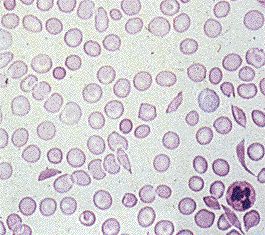Sickle cell anemia

Sickle cell anemia is a nearly lethal condition in humans, responsible for about 100, 000 deaths a year. About 80% of individuals with this condition die before reproducing. Yet despite such apparently strong selection against the gene responsible for sickle cell hemoglobin, it is maintained at frequencies of 10% or even more in some human populations. Why is this?
The answer was first suggested by Haldane and confirmed by Allison. Sickle cell anemia is caused by a genetic variant of a-hemoglobin. If we symbolize the normal hemoglobin allele by A and the sickle cell hemoglobin by S, then people who suffer from sickle cell anemia are SS. Haldane compared a map of the incidence of malaria with a map of the gene frequency: they are strikingly similar. Perhaps hemoglobin S provides some advantage in malarial zones.
It turned out that, although SS is almost lethal, the heterozygote AS is more resistant to malaria than the homozygote AA. AS red blood cells are more difficult for the malarial parasite Plasmodium falciparum to colonize. Therefore, where the malarial parasite is common, AS humans survive better than AA, which suffer from malaria.
This situation maintains polymorphism in many populations. It is known as heterozygous advantage, and is not uncommon in population genetics.
| Next |



